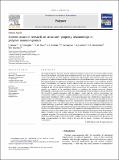Current issues in research on structure–property relationships in polymer nanocomposites
Author(s)
Jancar, J.; Douglas, J. F.; Starr, F. W.; Kumar, S. K.; Cassagnau, P.; Lesser, A. J.; Sternstein, S. S.; Buehler, Markus J.; ... Show more Show less
DownloadJancar-2010-Current issues in re.pdf (3.381Mb)
PUBLISHER_CC
Publisher with Creative Commons License
Creative Commons Attribution
Terms of use
Metadata
Show full item recordAbstract
The understanding of the basic physical relationships between nano-scale structural variables and the macroscale properties of polymer nanocomposites remains in its infancy. The primary objective of this article is to ascertain the state of the art regarding the understanding and prediction of the macroscale properties of polymers reinforced with nanometer-sized solid inclusions over a wide temperature range. We emphasize that the addition of nanoparticles with large specific surface area to polymer matrices leads to amplification of a number of rather distinct molecular processes resulting from interactions between chains and solid surfaces. This results in a “non-classical” response of these systems to mechanical and electro-optical excitations when measured on the macroscale. For example, nanoparticles are expected to be particularly effective at modifying the intrinsic nano-scale dynamic heterogeneity of polymeric glass-formation and, correspondingly, recent simulations indicate that both the strength of particle interaction with the polymer matrix and the particle concentration can substantially influence the dynamic fragility of polymer glass-formation, a measure of the strength of the temperature dependence of the viscosity or structural relaxation time. Another basic characteristic of nanoparticles in polymer matrices is the tendency for the particles to associate into extended structures that can dominate the rheological, viscoelastic and mechanical properties of the nanocomposite so that thermodynamic factors that effect nanoparticle dispersion can be crucially important. Opportunities to exploit knowledge gained from understanding biomechanics of hierarchical biological protein materials and potential applications in materials design and nanotechnology are among future research challenges. Research on nanocomposites formed from block copolymers and nanoparticles offers huge promise in molecular electronics and photovoltaics. The surface functionalization of nanoparticles by the grafting of polymer brushes is expected to play important role in the designing of novel organic/inorganic nanocomposite materials. The formation of bulk heterojunctions at the nanometer scale leads to efficient dissociation of the charge pairs generated under sunlight. Based on the presentations and discussion, we make recommendations for future work in this area by the physics, chemistry, and engineering communities.
Date issued
2010-05Department
Massachusetts Institute of Technology. Department of Civil and Environmental EngineeringJournal
Polymer
Publisher
Elsevier
Citation
Jancar, J., J.F. Douglas, F.W. Starr, S.K. Kumar, P. Cassagnau, A.J. Lesser, S.S. Sternstein, and M.J. Buehler. “Current Issues in Research on Structure–property Relationships in Polymer Nanocomposites.” Polymer 51, no. 15 (July 2010): 3321–3343.
Version: Final published version
ISSN
00323861